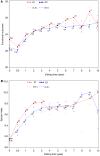Quality of life after curative gastrectomy for gastric cancer in a randomised controlled trial
- PMID: 18182977
- PMCID: PMC2359701
- DOI: 10.1038/sj.bjc.6604097
Quality of life after curative gastrectomy for gastric cancer in a randomised controlled trial
Abstract
Quality of life (QOL) was studied in gastric cancer patients treated on a randomised, controlled trial comparing D1 (level 1) with D3 (levels 1, 2 and 3) lymphadenectomy. A total of 221 patients were randomly assigned to D1 (n=110) and D3 (n=111) surgery. Quality-of-life assessments included functional outcomes (a 14-item survey about treatment-specific symptoms) and health perception (Spitzer QOL Index) was performed before and after surgery at disease-free status. Patients suffered from irrelative events such as loss of partners was excluded thereafter. Main analyses were done by intention-to-treat. Thus, 214 D1 (106/110=96.4%) and D3 (108/111=97.3%) R0 patients were assessed. Longitudinal analysis showed that functional outcomes decreased at 6 months after surgery and increased over time thereafter, while health perceptions increased over time in general. On the basis of linear mixed model analyses, patients having total gastrectomy, advanced cancer and hemipancreaticosplenectomy, but not complications had poorer QOL than those without. D1 and D3 patients showed no significant difference in QOL. The results suggest that changes of QOL were largely due to scope of gastric resection, disease status and distal pancreaticosplenectomy, rather than the extent of lymph node dissection. This indicates that nodal dissection can be performed for a potentially curable gastric cancer.
Figures

References
-
- Aaronson NK, Ahmedzai S, Bergman B, Bullinger M, Cull A, Duez NJ, Filiberti A, Felchtner H, Fleishman DB, De Haes JCJM, Kaasa S, Klee M, Osoba D, Razavi D, Rofe P, Schraub S, Sneeuw K, Sullivan M, Takeda F (1993) The European Organization for Research and Treatment of Cancer QLQ-C30: a quality-of-life instrument for use in international clinical trials in oncology. J Natl Cancer Inst 85: 365–376 - PubMed
-
- Bonenkamp JJ, Songun I, Hermans J, Sasako M, Welvaart K, Plukker JTM, van EIK P, Obertop H, Gouma DJ, Taat CW, van Lanschot J, Meyer S, de Graaf PW, von Meyenfeldt MF, Tilanus H, van de Velde CJH (1995) Randomised comparison of morbidity after D1 and D2 dissection for gastric cancer in 996 Dutch patients. Lancet 345: 745–748 - PubMed
-
- Buhl K, Schlag P, Herfarth C (1990) Quality of life and functional results following different types of resection for gastric carcinoma. Eur J Surg Oncol 16: 404–409 - PubMed
-
- Cella DF, Tulsky DS, Gray G, Sarafian B, Linn E, Bonomi A, Silberman M, Yellen SB, Winicour P, Brannon J (1993) The Functional Assessment of Cancer Therapy scale: development and validation of the general measure. J Clin Oncol 11: 570–579 - PubMed
-
- Cuschieri A, Fayers P, Fielding J, Craven J, Bancewicz J, Joypaul V, Cook p, for The Surgical Cooperative Group (1996) Postoperative morbidity and mortality after D1 and D2 resections for gastric cancer: preliminary results of the MRC randomized controlled surgical trial. Lancet 347: 995–999 - PubMed
Publication types
MeSH terms
LinkOut - more resources
Full Text Sources
Medical

